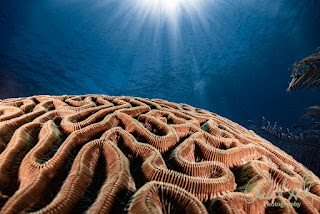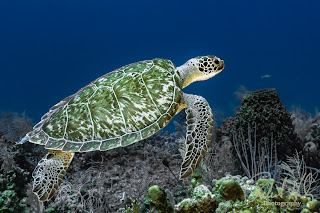Storytelling Through Underwater Photography
How to Narrate Compelling Stories with Your Photos
Underwater photography is more than just capturing beautiful images; it's about narrating a compelling story. Following these steps, you can tell engaging stories through your underwater photos, with the "Spotted Drum" fish as our example.
1. Plan Your Story
Before you dive, decide the narrative you want to capture.
For instance, with the "Spotted Drum", you might focus on its behavior,
habitat, and interactions within the reef. Think about the beginning, middle,
and end of your story to create a cohesive narrative.
2. Research Your Subject
Understanding the Spotted Drum's behavior and habitat
will help you anticipate moments worth capturing. Spotted Drum are known
for their distinctive juvenile and adult stages, each with unique patterns and
behaviors. Knowing their peak activity times and preferred hiding spots can
significantly enhance your storytelling.
3. Compose Thoughtfully
Composition is key to storytelling. Use techniques like the
rule of thirds, leading lines, and framing to draw viewers' eyes to the main
subject. For example, position the Spotted Drum in a way that highlights
its beautiful patterns and the vibrant coral backdrop, creating a dynamic and
engaging scene.
4. Capture a Sequence of Shots
Instead of a single shot, aim for a sequence that tells a
full story:
- Wide
Shot: The entire reef environment where the Spotted Drum fish lives.
- Medium
Shot: The fish swimming among the corals.
- Close-Up:
A detailed shot of the Spotted Drum fish’s distinctive patterns.
- This
sequence provides context, action, and detail, making your story more
engaging.
5. Focus on Emotion and Interaction
Capture moments that depict emotion or interaction. Seek out scenes in which the Spotted Drum is engaging with its surroundings or other marine life. This could involve a young Spotted Drum darting playfully through the water or an adult seeking shelter in a coral crevice. These moments will add depth and emotion to your story.
6. Use Light to Your Advantage
Lighting can dramatically influence your story. Use natural
light to create a serene, magical atmosphere or artificial light to highlight
details and add drama. For the Spotted Drum, lighting can accentuate its
patterns and the textures of the coral reef, adding to the visual appeal.
7. Incorporate Human Elements
Including divers or researchers in your shots can provide
scale and a sense of adventure. A diver observing a Spotted Drum can add
a personal connection and show the scale of the marine environment, making the
story more relatable and immersive.
8. Edit with a Narrative in Mind
Post-processing is where you can enhance your story. Use
Adobe Lightroom to consistently adjust colors, contrast, and sharpness across
your sequence of images. This consistency helps maintain the narrative flow and
emphasizes the key elements of your story.
9. Add Captions and Descriptions
Informative captions add context and depth to your photos.
Describe the behavior of the Spotted Drum, share interesting facts, and
convey your personal experiences and emotions. For example, explain how the
juvenile Spotted Drum fish’s long dorsal fins help it navigate its environment. Show a picture story of the three stages of growth for the Spotted Drum (Juvenile, intermediate, and adult).
10. Share Your Story
Share your finished story through your blog, social media,
or exhibitions. Engage with your audience by inviting comments, questions, and
discussions. This interaction can enrich the storytelling experience and build
a community around your work.
Example Story: The Life of a "Spotted Drum" Fish
- Wide
Shot: An expansive view of the coral reef, setting the scene and
introducing the vibrant environment where the Spotted Drum fish lives.
- Medium
Shot: The Spotted Drum swimming gracefully among the corals,
showcasing its habitat and daily activity.
- Close-Up:
A detailed shot of the juvenile Spotted Drum with its elongated
dorsal fin and striking patterns, capturing a moment of beauty and
uniqueness.
- Human
Element: A diver photographing the Spotted Drum fish, adding scale and
a sense of adventure to the narrative.
- Final
Shot: The reef at sunset, providing closure and reflection on the
beauty and fragility of the underwater world.
Conclusion
Telling stories through underwater photography is an art that requires more than just technical skill. It involves capturing the essence of marine life and sharing the wonders of the underwater world in a way that emotionally resonates with viewers. By planning your story, understanding your subjects, composing thoughtfully, and using light creatively, you can transform your underwater photos into compelling narratives.
Incorporate sequences of shots, focus on interactions, and add human elements to provide scale and connection. Post-process with a consistent narrative in mind and enhance your photos with descriptive captions that provide context and insight.
Sharing your underwater stories can inspire others to appreciate and protect the marine environment. By inviting your audience into your world, you create a shared experience that goes beyond the visual and fosters a deeper connection to the beauty and fragility of the ocean.
Happy diving and storytelling! Your underwater adventures are just the beginning of the stories waiting to be told.
Stay Connected
Follow my blog for more tips and tutorials on underwater photography. Let's dive deeper into the art and craft of capturing the marine world!
Subscribe to my blog for more tips and tutorials on underwater photography. Don’t forget to share your processed photos on social media using the hashtag #RobertHerbPhotography. I look forward to reviewing your results.
New Online Training Program
I am excited to announce that I am creating an online training program to teach underwater hobbyists and enthusiasts how to enhance their photos using Adobe Lightroom. If you are interested in this training, please contact me at bob@robertherb.com to express your interest and to be notified about the details and start date of the classes.
Stay tuned and "Follow" for upcoming blogs on underwater photography tips and tricks for more in-depth insights. Please leave your comments and suggestions. Enjoy your diving and shooting experience!
I am eagerly anticipating your valuable feedback and suggestions.
Sincerely,
Bob Herb
|
|





Comments
Post a Comment
Please let me know your comments.